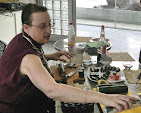Sauce piquant to put on conies
3 period sauces from the one recipe
“Du fait de cuisine”
was written by Master Chiquart on the behest of the Duke of Savoy in
1420. In it Chiquart outlines all his knowledge about creating
banquets for the 15th
century French nobility. The recipes are often on a huge scale –
for example, the book starts by listing the amount of meat to order,
starting with 100 cattle, 130 sheep, 120 pigs plus 100 piglets for
each day and 60 salted pigs for larding and making soups.
So when reading the
recipes, one must consider that they are for feasts on a grand scale,
and take this into consideration when devising a much more reasonable
quantity.
The recipe I have chosen
to make is the 14th
in the manuscript. Unfortunately the only original French version I
have obtained so far is just that – the original manuscript and I
have not managed to decypher the writing yet. So I have used the
translation by Elizabeth Cook, who's translations have proven in my
experience to be reasonably accurate. Here is her translation:
To
make sauce piquant to put on conies, according to the quantity of it
which one is making take onions and chop them fine, and take fair
pork lard and melt it and sauté your onions, and so that they do not
burn in sautéing put a little broth in; and then put in a great deal
of white wine according to the quantity of sauce piquant which you
want to make for the said conies; and take your spices, good ginger,
grains of paradise, a little pepper which is not at all too much, and
saffron to give it color; and season it with vinegar in such
proportion that it is neither too much poignant nor too little; with
salt also.
There are thousands of variations that
can be made from any one original recipe. As I am ever curious about
medieval cuisine and frequently make 10-20 versions of any medieval
recipe, I decided to do three sauces from the one recipe, varying the
type of wine, amounts, and the amounts of spices and onions. For the
first two, I have made sauces that are quite thin. However with the
third, I made the decision to make something that would be thicker
and with a lot more onion, almost a spicy relish rather than what we
would classically think of as a sauce.
The methodology was the pretty much the
same for all three sauces, so I will describe that once, and note the
differences after the ingredients list for each variation:
- Chop the onions finely
- Take a saucepan and melt the pork lard in it
- Add the onions and sauté until soft, adding broth a spoonful at a time if the mixture starts looking dry
- Add the wine, keeping on the heat (the original recipe does not specify but as the wine is added to the onions which are on the heat, it is a logical conclusion that it would stay on the heat)
- Add the ground spices – the saffron was ground with a tiny touch of broth to release the colour before putting into the sauce.
- Simmer for 15-20 minutes
- Remove from the heat and add the vinegar, then season to taste.
Sauce for Conies Version 1.
1 onion
1tsp lard
2 tablespoons chicken broth
2 cups Sauvignon Blanc
12 threads saffron
1 pinch ground Grains of Paradise
1 tsp ginger
2 tablespoons white wine vinegar
1 pinch of ground black pepper
1 pinch of salt
2 tablespoons white wine vinegar
I chose Sauvignon Blanc as a wine
variety that existed within period, in the south of France, so
accessible to the Savoyard chef.
Sauce for Conies Version 2
2 onions
2 tsp lard
2 tablespoons chicken broth
2 cups Chardonnay
3 pinches grains of paradise
½ teaspoon ginger
8 threads saffron
2 tablespoons white wine vinegar
1 pinch ground black pepper
1 pinch of salt
Chardonnay originated in Burgundy, in
the mid-eastern part of France and would also have been accessible.
The oak matured citrus notes of the chardonnay seemed to be
appropriate for a piquant sauce. I chose to use more grains of
paradise than ginger to make a less obviously spicy sauce.
Sauce for Conies Version 3
3 onions
3 tablespoons lard
2 tablespoons chicken stock
1 and a half cups McGuigan classic
white wine
12 threads saffron
½ tsp Grains of Paradise
1 ¼ tsp ginger
a good pinch of black pepper
1 pinch of salt
2 tablespoons white wine vinegar
I chose this as a reasonably generic
white wine, without any dominant flavours.
I decided that this version should be more like a sort of chutney - a thick rich condiment. With this much lard, it certainly is rich - but the fat is balanced well by the wine and vinegar. Of the three redactions, this one is my favourite.
A short comment on cooking methods
The sauces in this recipe would most
likely have been made in a large cauldron hung over a fire. While
many cooks claim that this means that there was little control over
the heat and cooking processes in a medieval kitchen, I challenge
this claim.
An experienced cook, especially one of
Chiquart's credentials, had a very good idea of how hot or cool the
fires were on which he cooked. By changing from cooking over flame
to embers, stoking, adding wood, removing wood, raising and lowering
pots from above the fire-grate, a great deal of control can be made
to the cooking process.
While modern cooking appliances are
easier, stoves, whether gas or electric, still only have a range of
numbers on them, so the cook is still left with decisions to adjust
and change the heat on their cooking.



No comments:
Post a Comment